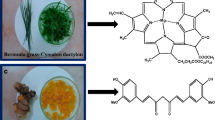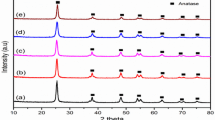Abstract
Pure and tin-incorporated TiO2 (Sn-TiO2) nanoparticles were prepared utilizing photolysis method. Field emission-scanning electron microscope (FESEM) and transmission electron microscopy (TEM) reveal the formation of fusiform and spherical agglomeration nanoparticles with mesoporous structure and size that is equal to 20 nm approximately. The preparation of 5%Sn:TiO2 is confirmed by energy dispersive X-ray (EDX), and the empirical formal is Sn0.05TiO4. X-ray diffraction (XRD) studies confirm that they have a 4 nm crystallite size and crystallized as an anatase phase of TiO2. X-ray photoelectron spectroscopy (XPS) revealed that 1% Sn4+ was successfully incorporated with TiO2 and that Ti3+ is presented as an electron trap. Raman spectrum shows a higher shift of TiO2 peaks with in Sn:TiO2. The band gap decreases with increasing Sn4+ incorporating ratio and reaching a minimum value of 2.62 eV corresponding to 5% Sn:TiO2, as well as the adsorption spectrum of Sn4+-incorporated TiO2 has an excellent transmittance with increasing Sn4+ incorporating from 5% weight ratio until reaching 85%. The results obtained that the optimum conditions for working Sn:TiO2 as a DSSCs are 5%Sn incorporation ratio and pH = 3. EIS measurements were used to quantify the kinetics of interfacial charge transfer, such as chemical capacitance, electron recombination lifespan, charge transfer resistance, charge collection efficiency, and charge transfer resistance. Enhanced power conversion is equal to 12.32% for %5Sn:TiO2/based N3 dye/Ag at pH = 3 by using solar simulator (100 mW/cm2).



















Similar content being viewed by others
Data availability
All data generated or analyzed during this study are included in this published article.
References
A. Polman, M. Knight, E.C. Garnett, B. Ehrler, W.C. Sinke, Photovoltaic materials: Present efficiencies and future challenges. Science. 352(6283), 4424 (2016). https://doi.org/10.1126/science.aad4424
A.M. Ammar, G.M. Abdel-Hafez, H.S. Mohamed, A.S. Hassanien, M.M. Yousef, A.S. Khalil, Dye-sensitized solar cells (DSSCs) based on extracted natural dyes. J. Nanomater. (2019). https://doi.org/10.1155/2019/1867271
N.T.M. Rosana, D.J. Amarnath, P.S. Kumar, K.L.V. Joseph, Potential of plant-based photosensitizers in dye-sensitized solar cell applications. Environ. Prog. Sustain. Energy (2019). https://doi.org/10.1002/ep.13351
Ismail Cihan Kaya, Seckin Akin, Hasan Akyildiz, Savas Sonmezoglu, Highly efficient tandem photoelectrochemical solar cells using coumarin6 dye-sensitized CuCrO2 delafossite oxide as photocathode. Solar Energy. 169, 196–205 (2018)
E. Cuce, C.-H. Young, S.B. Riffat, Thermal performance investigation of heat insulation solar glass: A comparative experimental study. Energy Build. 86, 595–600 (2015)
E. Cuce, S.B. Riffat, C.-H. Young, Thermal insulation, power generation, lighting and energy saving performance of heat insulation solar glass as a curtain wall application in Taiwan: A comparative experimental study. Energ. Convers. Manag. 96, 31–38 (2015)
T. Ozturk, B. Gulveren, M. Gulen, E. Akman, S. Sonmezoglu, An insight into titania nanopowders modifying with manganese ions: A promising route for highly efficient and stable photoelectrochemical solar cells. Solar Energy. 157, 47–57 (2017)
X. Xiao, X. Zhang, H. Su, S. Chen, Z. He, C. Zhao, S. Yang, A visible-NIR responsive dye-sensitized solar cell based on diatom frustules and cosensitization of photopigments from Diatom and purple bacteria. J. Chem. (2020). https://doi.org/10.1155/2020/1710989
Y. Huang, H. Wu, Q. Yu, J. Wang, C. Yu, J. Wang, S. Gao, S. Jiao, X. Zhang, P. Wang, Single-layer TiO2 film composed of mesoporous spheres for high-efficiency and stable dye-sensitized solar cells. ACS Sustain. Chem. Eng. 6, 3411–3418 (2018)
D. Zhou, Q. Yu, N. Cai, Y. Bai, Y. Wang, P. Wang, Efficient organic dye-sensitized thin-film solar cells based on the tris(1,10-phenanthroline) cobalt (II/III) redox shuttle. Energy Environ. Sci. 4, 2030–2034 (2011)
B. He, X. Meng, Q. Tang, Low-cost counter electrodes from CoPt alloys for efficient dyesensitized solar cells. ACS Appl. Mater. Interfaces 6, 4812–4818 (2014)
R. Grover, N. Gupta, O. Nanda, K. Saxena, Aligned Zinc Oxide Nanostructures for Dye-Sensitized Solar Cells: A Review, in Advances in Solar Power Generation and Energy Harvesting. ed. by V. Jain, V. Kumar, A. Verma (Springer, Singapore, 2020)
S. Mahalingam, H. Abdullah, Electron transport study of indium oxide as photoanode in DSSCs: A review. Renew. Sustain. Energy Rev. 63, 245–255 (2016)
D. Devadiga, M. Selvakumar, P. Shetty et al., Dye-sensitized solar cell for indoor applications: A mini-review. J. Electron. Mater. 50, 3187–3206 (2021). https://doi.org/10.1007/s11664-021-08854-3
M.Z. Toe, S.Y. Pung, K.A. Yaacob et al., Effect of TiO2 sol on the conversion efficiency of TiO2 based dye-sensitized solar cell. J Sol-Gel Sci Technol 95, 439–446 (2020). https://doi.org/10.1007/s10971-020-05325-9
X. Wang, Z. Li, J. Shi, Y. Yu, One-dimensional titanium dioxide nanomaterials: nanowires, nanorods, and nanobelts. Chem. Rev. 114, 9346–9384 (2014)
G. Liu, L. Kong, P. Guo, C.C. Stoumpos, Q. Hu, Z. Liu, Z. Cai, D.J. Gosztola, H. Mao, M.G. Kanatzidis et al., Two regimes of bandgap red shift and partial ambient retention in pressure-treated two-dimensional perovskites. ACS Energy Lett. 2, 2518–2524 (2017)
G. Liu, J. Gong, L. Kong, R.D. Schaller, Q. Hu, Z. Liu, S. Yan, W. Yang, C.C. Stoumpos, M.G. Kanatzidis et al., Isothermal pressure-derived metastable states in 2D hybrid perovskites showing enduring bandgap narrowing. Proc. Natl. Acad. Sci. USA 115, 8076–8081 (2018)
R. Jose, V. Thavasi, S. Ramakrishna, Metal oxides for dye-sensitized solar cells. J. Am. Ceram. Soc. 92, 289–301 (2009)
Z.H. Mahmoud, R.A. AL-Bayati, A.A. Khadom, Synthesis and supercapacitor performance of polyaniline-titanium dioxide-samarium oxide (PANI/TiO2-Sm2O3) nanocomposite. Chem. Pap. (2021). https://doi.org/10.1007/s11696-021-01948-6
A. Saedi, A.M. Moradi, S. Kimiagar et al., Efficiency enhancement of dye-sensitized solar cells based on Gracilaria/Ulva using graphene quantum dot. Int J Environ Res 14, 393–402 (2020). https://doi.org/10.1007/s41742-020-00265-2
Tetiana A. Dontsova, Anastasiya S. Kutuzova, Kateryna O. Bila, Svitlana O. Kyrii, Iryna V. Kosogina, Daria O. Nechyporuk, Enhanced photocatalytic activity of TiO2/SnO2 binary nanocomposites. J.Nanomater. (2020). https://doi.org/10.1155/2020/8349480
A.D. French, Increment in evolution of cellulose crystallinity analysis. Cellulose 27, 5445–5448 (2020). https://doi.org/10.1007/s10570-020-03172-z
S. Sönmezoğlu, Synthesis and characterisations of nanostructured TiO2-Te:CdO compound thin films. Mater. Technol. 29(1), 3–7 (2014). https://doi.org/10.1179/175355513X13649076812440
F.K. Mammo, I.D. Amoah, K.M. Gani, L. Pillay, S.K. Ratha, F. Bux, S. Kumari, Microplastics in the environment: interactions with microbes and chemical contaminants. Sci. Total Environ. (2020). https://doi.org/10.1016/j.scitotenv.2020.140518
J. Du, G. Zhao, H. Pang, Y. Qian, H. Liu, D.J. Kang, Mater. Lett. 93, 419–422 (2013)
B. Das, S.K. Dash, D. Mandal, T. Ghosh, S. Chattopadhyay, S. Tripathy, S. Roy, Green synthesized silver nanoparticles destroy multidrug resistant bacteria via reactive oxygen species mediated membrane damage. Arab. J. Chem. 10(6), 862–876 (2017)
Shiming Ni, Fengyun Guo, Dongbo Wang, Shujie Jiao, Jinzhong Wang, Yong Zhang, Bao Wang, Pu. Feng, Liancheng Zhao, Modification of TiO2 nanowire arrays with Sn doping as photoanode for highly efficient dye-sensitized solar cells. Crystals 9, 113 (2019)
R. Mariappan, V. Ponnuswamy, P. Suresh, Superlattices Microstruct. 52, 500–513 (2012)
S.M. Ali, M.A.M. Khan, Annealing effects on structural, optical and electrical properties of TiO2/FTO heterojunction. Appl. Phys. A 126, 468 (2020). https://doi.org/10.1007/s00339-020-03656-6
S.S. Shinde, A.P. Korade, C.H. Bhosale, K.Y. Rajpure, J. Alloys Compd. 551, 688–693 (2013)
J. Liu, S.Y. Ma, X.L. Huang, L.G. Ma, F.M. Li, F.C. Yang, Q. Zhao, X.L. Zhang, Superlattices Microstruct. 52, 765–773 (2012)
A. Arunachalam, S. Dhanapandian, C. Manoharan, Effect of Sn doping on the structural, optical and electrical properties of TiO2 films prepared by spray pyrolysis. J Mater Sci: Mater Electron (2015). https://doi.org/10.1007/s10854-015-3802-9
P. Gnida, M. Libera, A. Pająk, E. Schab-Balcerzak, Examination of the effect of selected factors on the photovoltaic response of dye-sensitized solar cells. Energy Fuels 34(11), 14344–14355 (2020). https://doi.org/10.1021/acs.energyfuels.0c02188
Z. Ge, Y. Zhu, C. Wang et al., Investigation of the photoanode based on graphene/zinc aluminum mixed metal oxide for dye-sensitized solar cell. J. Sol. Gel. Sci. Technol. 95, 432–438 (2020). https://doi.org/10.1007/s10971-020-05310-2
K. Subalakshmi, J. Senthilselvan, K.A. Kumar, S.A. Kumar, A. Pandurangan, Solvothermal synthesis of hexagonal pyramidal and bifrustum shaped ZnO nanocrystals: natural betacyanin dye and organic Eosin Y dye sensitized DSSC efficiency, electron transport, recombination dynamics and solar photodegradation investigations. J. Mater. Sci. Mater. Electron. (2017). https://doi.org/10.1007/s10854-017-7445-x
V. Amoli, S. Bhat, A. Maurya, B. Banerjee, A. Bhaumik, A.K. Sinha, Tailored synthesis of porous TiO2 nanocubes and nanoparallelepipeds with exposed 111 facets and mesoscopic void space: a superior candidate for efficient dye-sensitized solar cells. ACS Appl. Mater. Interfaces 7, 26022–26035 (2015)
Y.P. Lin, Y.Y. Chen, Y.C. Lee, Y.W. Chen-Yang, Effect of wormhole-like mesoporous anatase TiO2 nanofiber prepared by electrospinning with ionic liquid on dyesensitized solar cells. J. Phys. Chem. C 116, 13003–13012 (2012)
K. Subalakshmi, J. Senthilselvan, Effect of fluorine-doped TiO2 photoanode on electron transport, recombination dynamics and improved DSSC efficiency. Sol. Energy 171, 914–928 (2018)
Author information
Authors and Affiliations
Contributions
The authors confirm contribution to the paper as follow: study conception, design, and data collection: ZHM; analysis and interpretation of results: RAA-B; draft manuscript preparation: AAK.
Corresponding author
Ethics declarations
Conflict of interest
We wish to confirm that there are no known conflicts of interest associated with this publication and there has been no significant financial support for this work that could have influenced its outcome.
Additional information
Publisher's Note
Springer Nature remains neutral with regard to jurisdictional claims in published maps and institutional affiliations.
Rights and permissions
About this article
Cite this article
Mahmoud, Z.H., AL-Bayati, R.A. & Khadom, A.A. Electron transport in dye-sanitized solar cell with tin-doped titanium dioxide as photoanode materials. J Mater Sci: Mater Electron 33, 5009–5023 (2022). https://doi.org/10.1007/s10854-021-07690-9
Received:
Accepted:
Published:
Issue Date:
DOI: https://doi.org/10.1007/s10854-021-07690-9




